An 85th anniversary look at the time Disney’s record division produced its first stereo Snow White album with the cream of Hollywood musical talent.
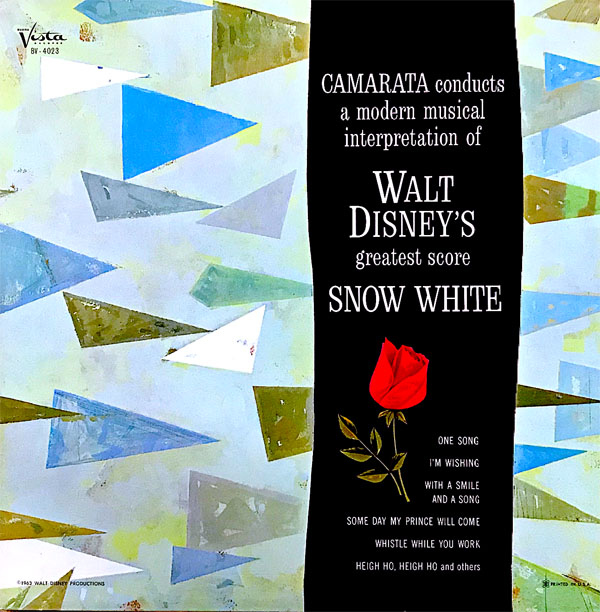
CAMARATA
Conducts a Modern Musical Interpretation of
Walt Disney’s Greatest Score
SNOW WHITE AND THE SEVEN DWARFS
Buena Vista Records BV-4023 (mono) STER-4023 (stereo) (12” LP 33 1/3 rpm) (Gatefold Cover with Banners & Rose)
LP Reissue: Buena Vista (1967) (Cover with Camarata Portrait)
Released in June 1963. Executive Producer: Jimmy Johnson. Producer/Conductor: Tutti Camarata. Vocalists Include: Norma Zimmer, Bill Lee, Bill Kanady. Engineers: Allan Emig, Bryan Ross-Myring.
Songs: “I’m Wishing,” “One Song,” “With a Smile and a Song,” “Whistle While You Work,” “Bluddle-Uddle-Um-Dum,” “Heigh-Ho,” “The Silly Song,” “Some Day My Prince Will Come,” “One Song (Reprise)” by Larry Morey and Frank Churchill.
 “There is no question that the score of Snow White is the greatest of any Walt Disney motion picture,” read the liner notes of this 1963 album. “No less than six of the songs were on the hit parade and many of the tunes have become best-selling standards. In view of the advent of magnetic tape for recording and stereophonic sound on records, we of the Disney organization felt that it was time for a new recording of Walt’s most famous score.”
“There is no question that the score of Snow White is the greatest of any Walt Disney motion picture,” read the liner notes of this 1963 album. “No less than six of the songs were on the hit parade and many of the tunes have become best-selling standards. In view of the advent of magnetic tape for recording and stereophonic sound on records, we of the Disney organization felt that it was time for a new recording of Walt’s most famous score.”
This was not a decision made lightly, though it seems like an obvious thing to do. The original soundtrack was a steadily strong seller, so a follow-up aimed at adult connoisseurs of stereo and high-fidelity sound during what would be the end of the suburban home stereo seemed to make sense. Records were still proclaiming “Living Stereo” and “Perfect Presence Sound.”
However, the early sixties brought severe budgetary changes to Disneyland and Buena Vista Records. Annette’s hit albums had floated the label, redirecting the marketing of the animated soundtracks to kids and relying on repacked material had greatly kept down costs while keeping new recorded products on store shelves. Producing a brand-new recording in Hollywood with the top musicians, rather than outsourcing it in Europe, was expensive, as was the music itself which Disney does not own to this day (Bourne Music owns the music from Snow White, Pinocchio, Dumbo and most Silly Symphony cartoons). Snow White was such a popular, evergreen title, it seemed worthwhile to create something new that would appeal to an audiophile and more general audience in addition to children.
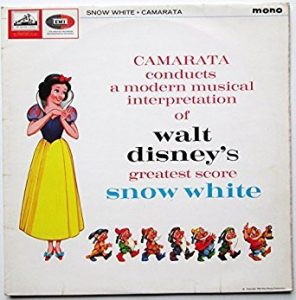 The cover design of the 1963 LP release makes it obvious that the plan was to keep this from looking like a “kiddie record.” The “modern art” freeform triangle pattern, single rose and elegant typeface are in keeping with something from Columbia or RCA Records. The interior gatefold is not packed with photos and copy but stylishly simple with plenty of “whitespace instead of clutter,” in art direction speak. This album used triangular flag-like shapes, while another album from 1963, 33 Great Walt Disney Motion Picture Melodies Conducted by Camarata, used fish-like oval shapes.
The cover design of the 1963 LP release makes it obvious that the plan was to keep this from looking like a “kiddie record.” The “modern art” freeform triangle pattern, single rose and elegant typeface are in keeping with something from Columbia or RCA Records. The interior gatefold is not packed with photos and copy but stylishly simple with plenty of “whitespace instead of clutter,” in art direction speak. This album used triangular flag-like shapes, while another album from 1963, 33 Great Walt Disney Motion Picture Melodies Conducted by Camarata, used fish-like oval shapes.
Disney Legend Salvador “Tutti” Camarata, a true giant of the industry about whom we talked in this Animation Spin, assembled musicians who had played on hundreds of major movie and television soundtracks. As the notes, presumably written by Disneyland-Vista President and founder Jimmy Johnson (see this Animation Spin for more about this Disney Legend) explain, “Soloists are well-known artists but contracts with other record companies prevent us from using their names.” This did not apply so much to singers Bill Lee and Bill Kanady, who were credited on various Disneyland Records. However, they could not be listed if the Snow White voice was missing, so all the singers were omitted.
Disney music historian Stacia Martin determined long ago that the singer is the renowned soprano Norma Zimmer. Disney fans know her voice if not her name, as she sang for the White Rose in Alice in Wonderland and within the title song of Cinderella, among many other projects for the studio. Before 1960, she might have been listed on the cover, as she was known best within the music industry as a studio singer and member of several prominent vocal groups. After Lawrence Welk made her the official “Champagne Lady,” she became a well-known TV star (Welk’s show was an ABC prime-time hit in its heyday, as was “sing along with” Mitch Miller). Therefore, her presence could not be used to sell the Buena Vista Record. This is not an uncommon occurrence, as singers, arrangers, and others within the field do favors for one another as friends.
Gatefold from the 1963 release (click to enlarge)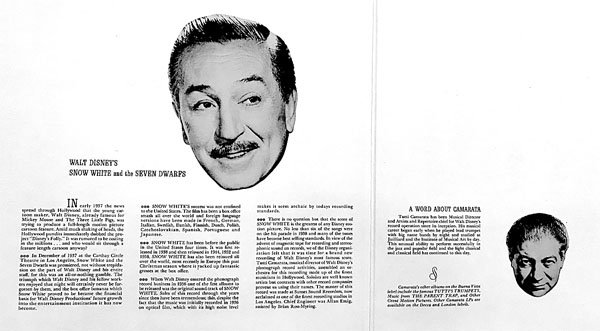
Tutti recorded the album at his Sunset Sound studio on Cherokee and Sunset Blvd, which is still operated by his son, Paul. That year, Sunset also was working on Disney records for Annette, The Beach Boys, and Hayley Mills, as well as prepping to produce the Mary Poppins soundtrack from editing and mixing to cutting the master discs. At the same time, the studio was currently or would soon to help create recordings for artists of such as The Doors, The Rolling Stones, Prince, Elton John, The Turtles, Janis Joplin, Led Zeppelin. Countless soundtracks, including Frozen 1 and 2, were also recorded, engineered, mixed and mastered in the historic facility.
 Some with knowledge of pop music and records in the sixties might wonder how this album could be called “modern” in the age of rock and roll and rhythm and blues. In the late fifties and early sixties, there were many other forms of music that were also in the forefront. Buena Vista was doing its best to represent as much as possible, from rock and roll, R&B and gospel albums to classical and jazz.
Some with knowledge of pop music and records in the sixties might wonder how this album could be called “modern” in the age of rock and roll and rhythm and blues. In the late fifties and early sixties, there were many other forms of music that were also in the forefront. Buena Vista was doing its best to represent as much as possible, from rock and roll, R&B and gospel albums to classical and jazz.
The Snow White musical style was designed to be “modern music” in the sense of mainstream American entertainment in 1963, the kind of thing one would see and hear in family films at theaters and on variety shows on three-network TV. Indeed, on his early sixties variety show, Danny Kaye said, “I think we can all agree that the sound of the sixties is bossa nova,” so the use of bossa nova in Tutti’s Snow White overture might make it modern by those show business standards.
One can imagine Tutti’s album as a videotaped, star-studded special in the TV landscape of The Jackie Gleason Show, Kraft Music Hall and Hollywood Palace. The Beatles were months away from their first appearance on The Ed Sullivan Show. Tutti had vast experience in conducting music for television “spectaculars,” as they were first called, including the historic pairing of Mary Martin and Noel Coward in “Together with Music,” and the original “Stingiest Man in Town” Christmas musical with Basil Rathbone.
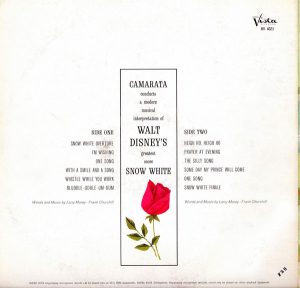 Tutti’s arrangements lend themselves so readily to TV musical variety, it’s easy to picture a troupe of dancers doing a square dance with costumed Seven Dwarfs during “Heigh-Ho,” perhaps Jane Powell trilling “I’m Wishing,” and Vic Damone crooning “One Song.” It’s the sort of thing Jimmy Johnson might have pitched to Walt, using the album as a demo. (Decades later, a musical comedy special saluting “Snow White” was indeed broadcast, with Saturday Night Live’s Jane Curtin as the Wicked Queen.)
Tutti’s arrangements lend themselves so readily to TV musical variety, it’s easy to picture a troupe of dancers doing a square dance with costumed Seven Dwarfs during “Heigh-Ho,” perhaps Jane Powell trilling “I’m Wishing,” and Vic Damone crooning “One Song.” It’s the sort of thing Jimmy Johnson might have pitched to Walt, using the album as a demo. (Decades later, a musical comedy special saluting “Snow White” was indeed broadcast, with Saturday Night Live’s Jane Curtin as the Wicked Queen.)
In 1967, Tutti’s album was reissued. A stylized painting of him appeared on the cover, conducting as a drawing of the Seven Dwarfs, positioned so they seemed to follow the baton (their illustration also appeared on the French/English LP). This release tied into the reissue of Snow White and the Seven Dwarfs to theaters.
With Mary Poppins securely established as one of filmdom’s most solid hits by 1967 and the Sherman Brothers’ score had earned its place among the finest in Disney history, the notes on the Snow White album had to be revised. The words “greatest score” were removed from the front cover; the back copy was updated to read “one of the greatest scores.”
The most-heard track on the album most likely became the Camarata Chorus version of “Heigh-Ho,” as it was the opening song on Walt Disney’s Happiest Songs, the 1967 premium compilation album offered by Gulf gas stations for one dollar and a gasoline fill-up. We explored this album and its 1968 follow-up, Walt Disney’s Merriest Songs, in this Animation Spin. Camarata’s version of Snow White remains Disney’s only studio album completely devoted to a reinterpretation of the score.
Overture Conducted by Camarata
Guests queueing up for the Storybook Canal Boats at Disneyland Park can hear this as part of the background music throughout the day. On the 1963 and 1967 issues, it was in mono on the otherwise stereo discs. The stereo version appeared only on 33 Great Walt Disney Motion Picture Melodies.
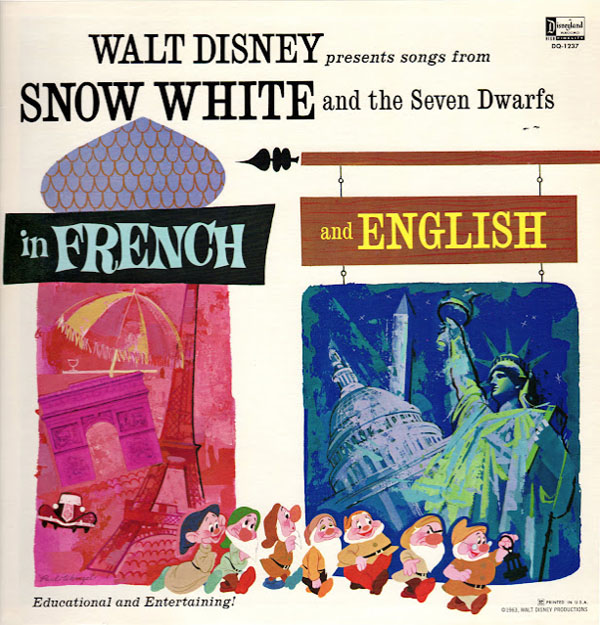
Walt Disney Presents Songs from
SNOW WHITE AND THE SEVEN DWARFS
In FRENCH and ENGLISH
Disneyland Records DQ- 1237 (mono) (12” LP 33 1/3 rpm)
Released in September 1963. Executive Producer: Jimmy Johnson. Producer/Conductor (English): Tutti Camarata. French Versions by Marcel Ventura, Assisted by Alfred Patio. French Language Vocalists: Christiane Legrand, Jean Cussac. English Language Vocalists: Norma Zimmer, Bill Lee.
Songs: “Je Souhaite (I’m Wishing),” “Un Sourire En Chantant (With A Smile and a Song),” “Sifflez En Travaillant (Whistle While You Work),” “Un Jour Mon Prince Viendra (Someday My Prince Will Come),” “Un Chant (One Song)” by Larry Morey, Frank Churchill.
The Camarata versions of five songs in English were combined with their counterparts in French on this album, also released in 1963. The French versions were recorded a year earlier for a 45 rpm EP, keeping each song short so they would all fit on the smaller disc. Snow White’s singing voice is that of Christiane Legrand, sister of Oscar-winning composer Michel Legrand (he also composed the music for the first Smurf feature, as discussed in this Spin).
Christiane Legrand was a popular artist in her own right. She also dubbed the singing for Anne Vernon in The Umbrellas of Cherbourg and Pamela Hart on The Young Girls of Rochefort.
Un Sourire en Chantant – Christiane Legrand
The sprightly arrangement of this and the other French versions on the EP have the sixties verve of The Umbrellas of Cherbourg and especially The Young Ladies of Rochefort. It makes one wonder if Michel Legrand was involved at all since his sister had done quite a lot of Disney work. Not only that but Cherbourg and Rochefort star Catherine Deneuve narrated the French Disney Cinderella Storyteller album!

[Special thanks to Francois Monferran, Bill Morgan and this article on the Filmic Light website for assistance with this post.]


 GREG EHRBAR is a freelance writer/producer for television, advertising, books, theme parks and stage. Greg has worked on content for such studios as Disney, Warner and Universal, with some of Hollywood’s biggest stars. His numerous books include Mouse Tracks: The Story of Walt Disney Records (with Tim Hollis). Visit
GREG EHRBAR is a freelance writer/producer for television, advertising, books, theme parks and stage. Greg has worked on content for such studios as Disney, Warner and Universal, with some of Hollywood’s biggest stars. His numerous books include Mouse Tracks: The Story of Walt Disney Records (with Tim Hollis). Visit 






















































Norma Zimmer fit into Disney songs like a hand into a glove. Her lovely soprano seemed designed to bring out the richness and the magic of Disney scores. Whenever the Lawrence Welk Show presented a tribute to Disney, which they did nearly once every year, Norma usually would be featured singing “When You Wish Upon a Star” in a flowing gown reminiscent of the Blue Fairy. The Lawrence Welk Show was the only television program my parents liked, so I grew up watching it whether my cup of tea or not.
When I listened to the main title sound track of “Song of the South,” I thought I recognized the soloist who performs one line, and I asked my mother if it could possibly be Norma Zimmer. She replied most emphatically that it was not, that Norma never did any work for Disney. Later on, when her autobiography came out, I skimmed the book looking for any further possible answer. She makes mention that she did, indeed, make some recordings for Disney although she does not disclose what specific recordings those were. It is such a throwaway line that my parents may have missed it entirely when they read the book.
Many years later, in the CD set “The Magical Music of Disneyland” released in time for the theme park’s 50th anniversary (which included as part of its tribute to Splash Mountain, the main title soundtrack from “S of the S”), the liner notes confirmed that I had been right all along, that the soloist was in fact Norma. I have since detected her voice in the soundtrack of “Cinderella” and a few other places as well. She also recorded for the Enchanted Tiki Room.
I have long been perplexed as to why no vocal credits were given for the Camarata album, which is perhaps the richest and most satisfying studio interpretation of the Snow White score. Even though there is no narration, the music feels as though the storytelling is woven into it. Though she did not receive star billing, within the context of the album itself Norma is given the star treatment. Makes one wonder what a live production would have been like. Vocally, she presents an iconic interpretation of the role of Snow White. Thanks for the clarification regarding the album’s credits!
That’s a strangely discordant ending to the Overture. Rossini and von Suppe wouldn’t have approved. It must be a segue into the scene with the evil queen and the magic mirror.
I think “modern” in this context was merely a selling point, to forfend against any imputations of “corniness”, the worst thing you could possibly say about any record in 1963. “Totally Squaresville, Daddy-O!”
I’ve seen Camarata’s given name spelled variously as Salvador (the Spanish and Portuguese form), Salvatore (the Italian form), and Salvadore (which I think is an Italian variant). Disney sources are pretty consistent about giving it as Salvador, but the other spellings crop up elsewhere. So… it’s definitely Salvador, then?
It is “Salvador” without the “e'” according to Paul Camarata.
Did Camarata do anymore movie based albums or was this the only one?
Besides the grand and glorious “Alice in Wonderland” album from 1957, in the late sixties he did a series of albums with The Mike Sammes Singers in London at Abbey Road Studios. These were orchestrated by Brian Fahey.
“Doctor Dolittle” featured songs from the 10th Century Fox feature (now part of the Disney library); and the scores from “Man of LaMancha,” Fiddler on the Roof,” and “Finian’s Rainbow,” which was released as a movie the same year in 1968. They also did some songs from “Oliver” and Chitty Chitty Bang Bang.” The other two scores for Disney were “The Happiest Millionaire,” “The Aristocats” and “Bedknobs and Broomsticks.”
10th Century? 20th Century? 21st Century? Modern Stone Age?
Christiane Legrand never was the French voice of Julie Andrews in “Mary Poppins”. A singer named Eliane Thibault was, as she also later was for “Darling Lili” and “Thoroughly Modern Millie”.
Miss Thibault was also Angela Lansbury’s singing voice in the original French dub of “Bedknobs ans Broomsticks”.
http://danslombredesstudios.blogspot.com/2011/09/eliane-thibault-supercalifragilisticexp_5159.html
Thank you, Lionel, the change will be made. The Mary Poppins voicing that Christiane Legrand did for Mary Poppins was for the French studio cast record album.
Did she also hit the trifecta and do the French-dubbed singing voice of Nora in Pete’s Dragon or was that someone else? It certainly wasn’t Helen Reddy even though she did a couple recordings of other songs in French.
That was triple-threat performer Nicole Croisille! https://www.youtube.com/watch?v=56FOiDhS1-o
Here’s another thing I did not know, according to the Walt Disney Archives: Elaine Thibault did not dub Angela Lansbury’s voice in Bedknobs and Broomsticks or in Beauty and the Beast. I cannot at this point research who it actually was, but perhaps it is listed on the French soundtracks. I have the B&B CD but not Bedknobs in French., sorry.
For the first french adaptation of B&B – 1972 – the singing was definitely done by Eliane Thibault, with the dialogue by stage actress Mony Dalmès, who also had appeared on Broadway in the cast of “Molly Brown”! https://www.youtube.com/watch?v=zBwE8vJhK1E …. The 2003 french adaptation has Brigitte Virtudes doing both singing and speaking for Angela Lansbury! https://wikidoublage.fandom.com/fr/wiki/L%27Apprentie_Sorci%C3%A8re
For the French LP, Michel Legrand may have had a hand in it, but the credited arranger and music director is Jean Baïtzouroff ………https://www.discogs.com/fr/artist/889938-Jean-Ba%C3%AFtzouroff
Strangely enough, Norma Zimmer had, two years previously, provided the singing voice for ice skating champ Carol Heiss, who played the title role in ”Snow White and The Three Stooges’, for Twentieth Century-Fox”.